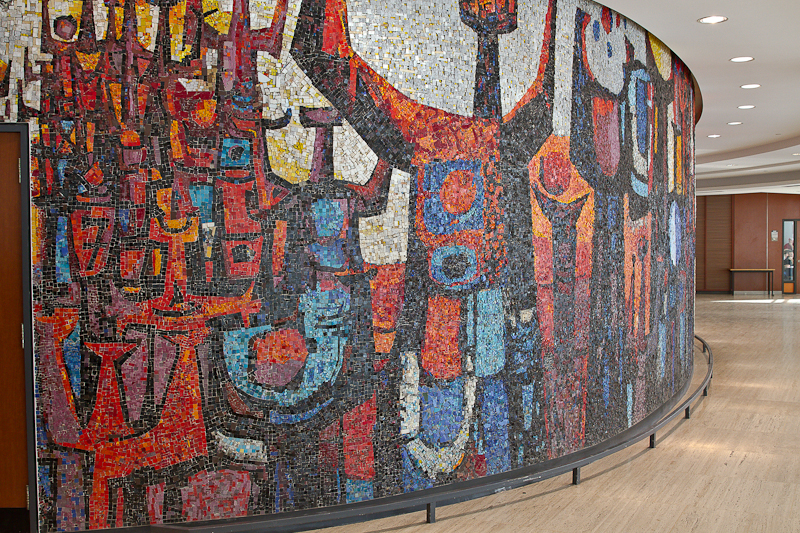
Walking through the Tory Building, whether you’re rushing to class or just taking a shortcut to get to the university centre, you’re sure to walk by an enormous mosaic enwrapping the building’s main lecture hall—“the egg,” as it’s fondly called.
The mural’s red and deep blue tiles sparkle in the sunlight forming the shape of figures reaching for success, earnestly trying to learn all they can.
“The Pilgrimage of Man” is a Carleton landmark and a milestone in its creator’s—Gerald Trottier—career.
“It means so much to me because his intention was that a student would be reaching to learn and the figures are also very meaningful, to me at least,” said Irma Trottier, Gerald’s widow and long-time partner.
Gerald died in 2004 at the age of 78, and the 10th anniversary of his passing is being remembered in a very public way. Irma has opened the Trottier home to the Ottawa Art Gallery, offering up the more than 1,000 pieces Gerald left behind to showcase in an upcoming April 2014 exhibition.
“I thought something had to be done because I’m not getting any younger,” Irma said.
She said she chose the Ottawa Art Gallery because of her husband’s history there. His show in 2002 was an “honest representation” of his work, according to Irma, showcasing many of his self-portraits from the 1990s, and was one of his favourites of his career.
“It was somewhere that my husband always thought, if he was to donate any work, this would be the place to do it,” she said.
The gallery’s senior curator, Catherine Sinclair, has been sharing many cups of tea with Gerald’s widow and their daughter, Denise, as they discuss bringing the exhibition, Gerald Trottier: Perspectives, to life.
“You get the impression of a complete devotion to the legacy of their father and husband,” Sinclair said. “They’re devoted to not letting his memory slip away and really promoting his work.”
It’s her job, she said, to “go out and fill in the gaps of what is missing in his story.”
Sinclair chose to include 102 of Trottier’s works ranging from his watercolours created during his days studying art in Ottawa and then New York City, to more introspective pieces from his latter years.
Out of all his accomplishments, he is perhaps most well remembered for his incredible mosaics and murals, such as the Tory Building piece at Carleton.
The piece is Irma’s favourite, she said, as she recalled how her late husband won a Canada-wide competition to create the piece. After more than a year of construction in Toronto, the piece was moved to the university and applied to the Tory Building’s walls in 1962, unveiled to then university president Davidson Dunton.
Trottier’s other murals cover the walls of the Ottawa Public Library, Mitel’s Kanata headquarters, and St. Michael’s College in Toronto, where he re-created the Last Supper.
Religion played a major part in Trottier’s work and life and as a devout Roman Catholic, Sinclair said. He went on a pilgrimage to Chartres, France while studying in Paris during the ‘50s. The experience changed his life and his art leading to his “medieval period,” she added.
“I’m astounded by his technical skill,” Sinclair said, but added it’s his conviction and the deeper thinking behind his art that makes him one of the few mid-century Ottawa artists who achieved real national and international recognition.
“He was obviously an extremely philosophical thinker, introspective person, and self-reflexive person. Not only is his work technically skilled, but it’s conceptually brilliant,” she said.
The exhibit will open April 10, with a reception on April 24, and will have pieces available for purchase.





